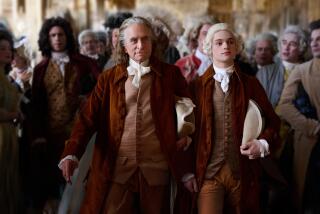Walking With Ben in Philly
- Share via
PHILADELPHIA — For six hours we have been walking with Ben Franklin through and around the “Miracle at Philadelphia.”
Now we are taking a break with him at the old City Tavern where delegates to the Constitutional Convention in the summer of 1787 sipped, relaxed, dined, socialized and planned strategies.
At the start of the Revolution, Paul Revere arrived at City Tavern after one of his historic rides to take news of England’s reaction to the Boston Tea Party.
Franklin was 81 at the time of the Constitutional Convention and he couldn’t have walked through the city as his spirit has walked with us today. But his words, thoughts and inspiration have been part of the audio tape that has been guiding us. We have set our own pace along the walk that will be a highlight for visitors during this Bicentennial year, the Constitution’s 200th birthday.
It’s a walk that can be as short or as long as you like. Key parts of the walk are accessible for wheelchairs, recalling that Franklin was frequently helped into the Constitutional sessions at Independence Hall; prisoners from the city jail carried him from his nearby home in a sedan chair that was made for him after his return from diplomatic service in France.
AudioWalk Tour
Even armchair visitors to Philadelphia can turn on a cassette for an AudioWalk Tour re-creating the late 18th Century in this city’s Independence Historical National Park.
I have been carrying the small rental cassette tape player while my wife Elfriede and I have been listening to the narration and music by two light cords with earphones.
When approaching one of the stops along the way, such as Independence Hall or Ben Franklin’s Court, we listen to the story of what we are about to see. City Tavern is at the midway point, and we are listening to the tape while sipping hot tea on this sunlit but brisk January afternoon and sharing a piece of oven-warm apple pie. An illustrated map with dotted trails is marked in sequence with the tape narration.
80-Minute Tape
AudioWalk Tour is the creation of Nancy Gilboy, who researched, wrote and produced the 80-minute tape. Her office is at the Norman Rockwell Museum at 6th and Walnut streets across from Independence Square where we began our walk. Rental fees for the tape player and cassette are $8 for one person, $12 for a couple, $16 for families.
You can buy a tape to play on your own equipment for $10.95 at the AudioWalk office or at bookstores, hotel gift shops and from the Philadelphia Convention & Visitors Bureau.
The tape tour covers what has long been known as the “most historic square mile in America,” a route that brings to life all the work, debate, idealism and drama that went into the “Miracle at Philadelphia” that created the constitutional foundation of democracy for a new nation.
The walk begins at the Liberty Bell Pavilion and the classic Georgian architecture of Independence Hall, where 55 delegates met in the Assembly Room in closed sessions from May 25 to Sept. 17, 1787.
In this room George Washington had been appointed commander in chief of the Continental Army in 1775. The Declaration of Independence was signed here on July 4, 1776.
Washington was called out of retirement to preside over the Constitutional Convention in an attempt to bring together a disintegrating confederation of states. We went inside for the 20-minute tour of Independence Hall conducted by the National Park Service.
Back outside, harpsichord music, recorded at Independence Hall for the AudioWalk tape, set the mood for imagining we were back in the 18th Century, walking brick sidewalks with “fashionable gentlemen in powdered wigs and velvet and satin clothes and their elegant ladies,” along with “mechanics in felt hats, leather aprons and buckskin breeches; visiting farmers in homespun and moccasins, black slaves and freed men; sailors and an occasional Indian. . . .”
Second Largest
By the time of the Constitutional Convention, cosmopolitan Philadelphia was the second largest English-speaking city in the world, prospering far beyond the dreams of Quaker William Penn, who had founded it as part of his “holy experiment” of brotherly love and religious freedom in 1662.
After our lunch break at City Tavern we stopped at Visitors Center to view “Independence,” the free 28-minute film on the origins of the nation, made here in the park by John Huston.
Carpenter’s Hall beyond the Visitors Center reflected in the January sunlight the skills brought to the New World by some of the finest carpenters and craftsmen of Europe in the 18th Century.
Just across Chestnut Street, Franklin Court showcases the life of the man who became wealthy and famous after leaving Boston for Philadelphia as a 17-year-old because he felt that William Penn’s city had the most to offer in the way of freedom and opportunity.
By the time of the Constitutional Convention, Franklin had long since made publishing and literary history with his annual “Poor Richard’s Almanac.” He had invented the lightning rod, the electrical battery, designed the lamps still seen throughout Independence Park, contributed to libraries, schools, hospitals and the paving of the city streets, and founded the first post office.
In 1783, after securing the aid from France that helped the Colonies win their freedom, he led negotiations for the Treaty of Paris that gave independence to the 13 Colonial states.
The story recalled for Bicentennial visitors brings to life the drama of Franklin’s participation with Washington, Madison and other founding fathers in the drafting of the Constitution. Despite his age and infirmity, he missed few sessions and helped in the compromise of many disputes, including the issue of slavery.
‘A Rising Sun’
Right after the convention he became the first president of the Pennsylvania Abolitionist Society. He hailed the signing of the Constitution as “a rising sun.”
The National Park Service has constructed in Franklin Court a steel silhouette of his home. In the underground museum we listened on simulated telephones to historical personalities talk about the meaning of Franklin’s life.
At the head of the courtyard, in the B. Free Franklin Post Office, the cards and letters you mail will be hand-canceled with the name of this post office.
The AudioWalk tour climaxes with the “Miracle at Philadelphia” exhibit in the Second National Bank in Independence Park, built after the war of 1812 to help stabilize the national currency. It houses the portraits of Colonial and independence leaders, along with a collection of hand-colored views of early Philadelphia.
The Bicentennial exhibit introduces you to the Constitutional delegates, lets you read James Madison’s secret notes about the convention, hear a re-creation of the debates, gives you a chance to sign the Constitution beside Benjamin Franklin’s own copy, asks your input on the compromises that made the Union possible.
On May 13 “A Promise of Permanency” exhibit will open in Independence Park’s Visitors Center. It will include an interactive cluster of computer stations designed to educate and involve visitors in the major Constitutional issues in the nation’s history, up to civil rights and other concerns of our own time.
On May 1 one of the few remaining copies of the Magna Carta from England will go on display in Old City Hall in Independence Park, housed in a reproduction of a 13th-Century tent.
“We the People 200” events will present a musical extravaganza on Benjamin Franklin Parkway May 22-25, spotlighting American music from pop to rock, blues to jazz.
During that same period the 1787 Festival next to Independence Hall will be a trip back in time with Colonial food and crafts. Starting June 1 the Please Touch Museum at 210 North 21st St. will have a Bicentennial exhibit for children. Stars will appear on stages and the skies will light up for the city’s Freedom Festival, July 3-5.
Special Session
On July 16 the Congress will convene in a special session in Philadelphia for the first time since 1800. The Maritime America gala Aug. 22-23 will feature the Philadelphia waterfront and Penn’s Landing with flotillas, ship visits, fireworks, outdoor parties.
On Sept. 17 “We the People 200” plans the largest parade ever presented in the nation, moving toward Independence Hall. It will involve national and state leaders and representatives from countries around the world to mark the 200th anniversary of the signing of the Constitution.
For details on the Bicentennial celebrations in Philadelphia, the restaurant and hotel renaissance and walking trails and historic sights in and around the nation’s fifth largest city, contact the Philadelphia Convention & Visitors Bureau, 1515 Market St., Suite 2020, Philadelphia, Pa. 19102. Telephone (215) 636-3330.
For an armchair visit or to prepare for the Bicentennial pilgrimage, contact AudioWalk & Tour, 601 Walnut St., Philadelphia, Pa. 19106. Telephone (215) 925-1234.
More to Read
Sign up for The Wild
We’ll help you find the best places to hike, bike and run, as well as the perfect silent spots for meditation and yoga.
You may occasionally receive promotional content from the Los Angeles Times.






